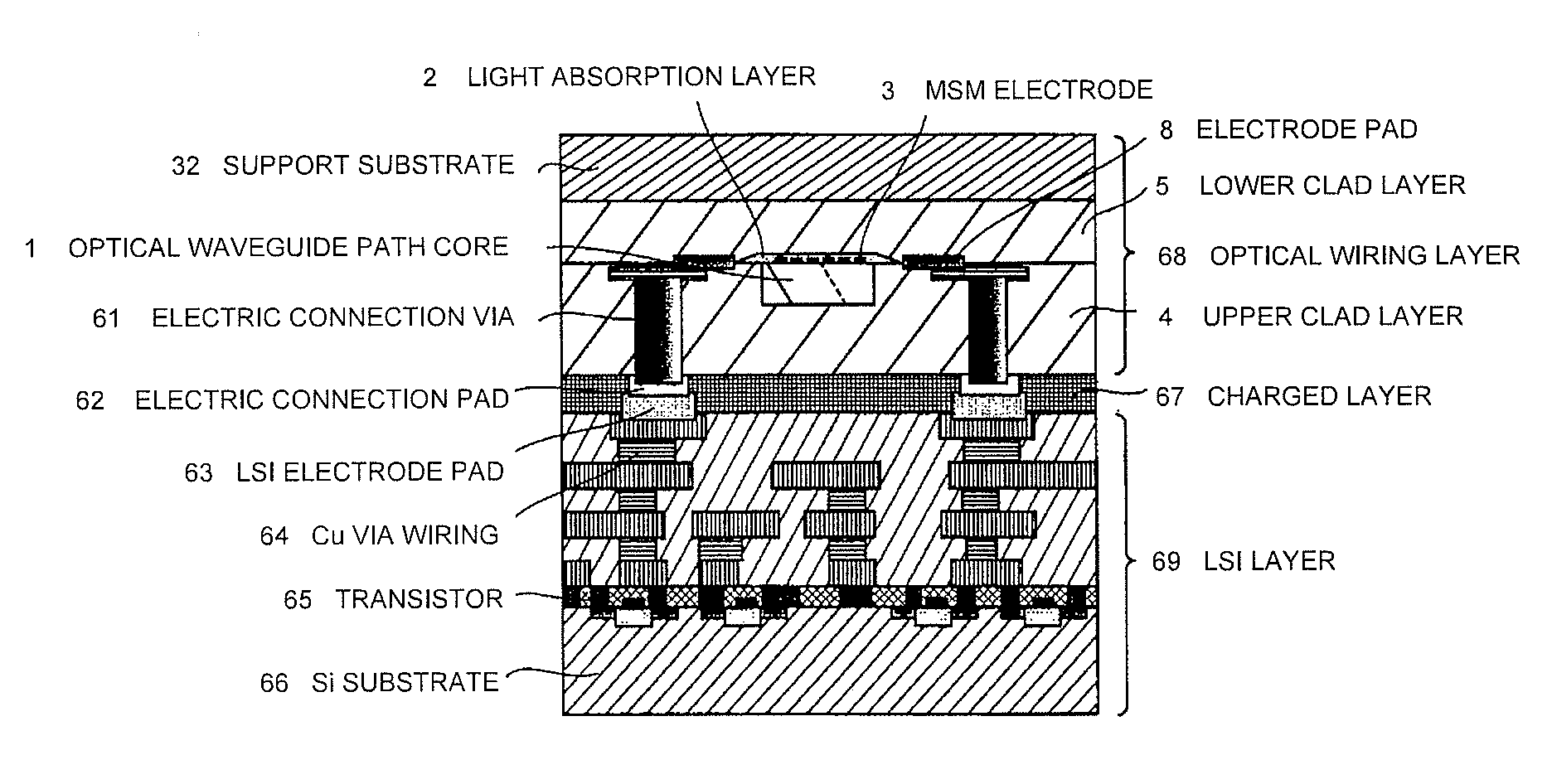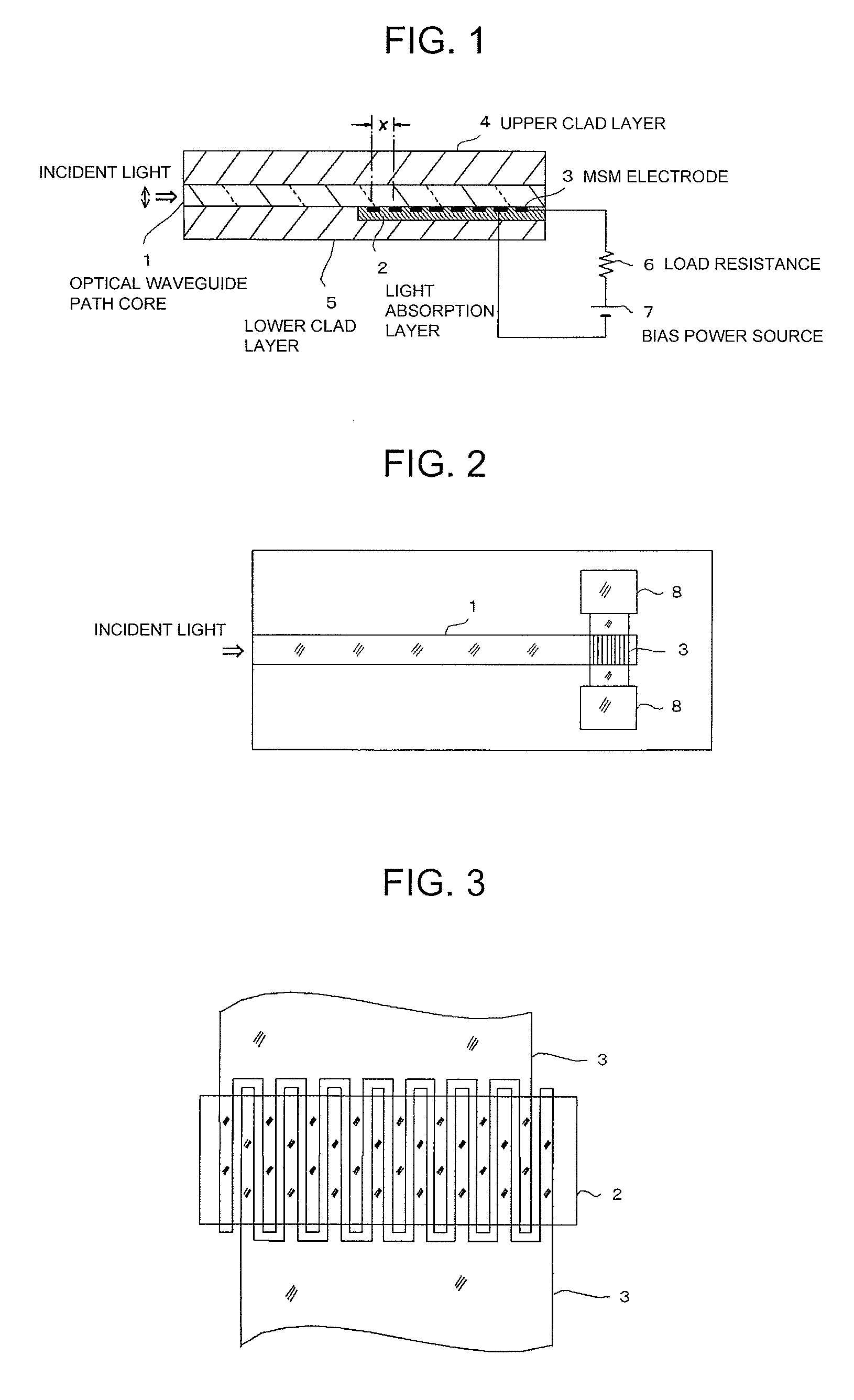Waveguide path coupling-type photodiode
a waveguide path and photodiode technology, applied in the field of photodiodes, can solve the problems of poor light absorption efficiency on the surface layer of the semiconductor, high speediness, and difficult to achieve high sensitivity, and achieve low power consumption, high integration, and efficient optoelectric conversion
- Summary
- Abstract
- Description
- Claims
- Application Information
AI Technical Summary
Benefits of technology
Problems solved by technology
Method used
Image
Examples
embodiment 1
[0091]Each of FIG. 1 to FIG. 3 is a view for explaining the first embodiment of the present invention. FIG. 1 is a cross sectional view. FIG. 2 is a plan. FIG. 3 is a partially enlarged view of FIG. 2.
[0092]Additionally, this embodiment is an example of the MSM photodiode.
[0093]This waveguide path coupling-type photodiode is one formed on one part of the semiconductor layer of which the surface has been insulated, for example, SOI (Silicon-on-Insulator). That is, the clad layer is formed so as to surround an optical waveguide path core 1. Additionally, for convenience, in FIG. 1, the clad layer being positioned on the upper side of the optical waveguide path core 1 is called an upper clad layer 4. The clad layer being positioned on the lower side of the optical waveguide path core 1 is called a lower clad layer 5. As can be seen from FIG. 1, the semiconductor light absorption layer 2 is formed in the boundary portion (interface portion) between the optical waveguide path core 1 and ...
embodiment 2
[0116]FIG. 6 is a cross sectional view illustrating the second embodiment of the present invention.
[0117]This embodiment is an example of the Schottky junction type photodiode.
[0118]This waveguide path coupling-type photodiode, similarly to the case of the first embodiment, has the semiconductor light absorption layer 2 formed adjacently to the optical waveguide path core 1. Further, similarly to the case of the first embodiment, the clad layer is formed around the optical waveguide path core 1. And, one electrode 11 (the comb type electrode similarly to the case of the first embodiment: the distance between the comb tooth is (1 / 100)λ to λ (where λ: a wavelength of the light that propagates through the optical waveguide path core)), out of one pair of the electrodes, is formed as a Schottky electrode. This Schottky electrode 11, similarly to the case of the first embodiment, is one formed in the boundary portion (interface portion) between the semiconductor light absorption layer 2 ...
embodiment 3
[0124]FIG. 7 is a cross sectional view illustrating the third embodiment of the present invention.
[0125]This embodiment is an example of the pin type photodiode.
[0126]This waveguide path coupling-type photodiode, similarly to the case of the first and second embodiments, has the semiconductor light absorption layer 2 formed adjacently to the optical waveguide path core 1. Further, similarly to the case of the first and second embodiments, the clad layer (the upper clad layer 4 and the lower clad layer 5) is formed around the optical waveguide path core 1.
[0127]And, one electrode (the comb type electrode), out of one pair of the electrodes, is configured with a layered structure of a metal film 23 and a p electrode 21. The other electrode (the comb type electrode), out of one pair of the electrodes, is configured with a layered structure of the metal film 23 and an n electrode 22. Thus, the p-i-n junction is configured of the electrodes of this embodiment and the semiconductor light ...
PUM
 Login to View More
Login to View More Abstract
Description
Claims
Application Information
 Login to View More
Login to View More - R&D
- Intellectual Property
- Life Sciences
- Materials
- Tech Scout
- Unparalleled Data Quality
- Higher Quality Content
- 60% Fewer Hallucinations
Browse by: Latest US Patents, China's latest patents, Technical Efficacy Thesaurus, Application Domain, Technology Topic, Popular Technical Reports.
© 2025 PatSnap. All rights reserved.Legal|Privacy policy|Modern Slavery Act Transparency Statement|Sitemap|About US| Contact US: help@patsnap.com



